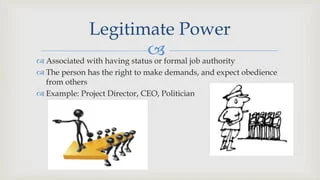
Hi all! As we continue our exploration into power bases, it is time to discuss legitimate power.
Legitimate power is the backbone of authority in the realm of leadership, setting it apart from other power bases. Unlike personal or relationship-based power (i.e. referent power), legitimate power is derived from formal positions within organizational hierarchies and societal structures. It is the power that accompanies a leadership role, providing individuals with the formal right to lead and make decisions. What distinguishes legitimate power is its foundation in the structure and rules of the system. It brings order and stability to organizations by establishing clear lines of authority and defining decision-making processes. When legitimate power is present, teams and individuals understand the chain of command, enabling them to navigate the hierarchy and work efficiently.

Legitimate power serves as the bedrock upon which effective leadership is built. When used correctly, effectively, and responsibly, it becomes a valuable tool in one’s leadership arsenal. However, if it is used in the wrong way, it can lead to low morale, resistance, and in extreme cases, mutiny. In the following, we will define legitimate power, discuss how one can use it to build trust and respect, positively persuade, and overcome challenges; and discuss the dark side of legitimate power.
Leveraging Legitimate Power: The Art of Persuasion
With a solid foundation of legitimacy established, we will explore the art of persuasion. While legitimate power provides a formal platform for influence, effective communication is essential for leveraging that power. Leaders must master the skill of persuasive communication to inspire and motivate others. Clear and compelling communication helps convey ideas, goals, and expectations, rallying individuals around a shared vision. Active listening plays a crucial role, enabling leaders to understand the needs and perspectives of their team members. Empathy allows leaders to connect on a deeper level, demonstrating genuine care and understanding. Building strong relationships is also vital, as people are more likely to be influenced by someone they trust and feel a connection with. Finding common ground and highlighting shared interests or goals fosters a sense of unity and facilitates collaboration. By honing these communication and relationship-building skills, leaders can effectively leverage their legitimate power and influence others to achieve shared objectives.
Overcoming Challenges: Navigating the Pitfalls
Even with legitimate power at hand, leaders may encounter challenges and pitfalls along their journey. Resistance from subordinates is a common challenge, stemming from factors such as differing perspectives, fear of change, or personal conflicts. To overcome resistance, leaders should engage in open and honest dialogue, address concerns, and seek mutual understanding.
Another challenge lies in the risk of abusing power. Leaders must remain vigilant and self-aware and use their power responsibly and ethically. Transparency, fairness, and checks and balances help prevent the misuse of power. Striking a balance between authority and humility is also crucial. Leaders should demonstrate humility by acknowledging their limitations, admitting mistakes, and seeking input from others. By navigating these challenges with integrity and empathy, leaders can overcome obstacles and maintain the trust and respect essential to their legitimate power.
The Dark Side of Legitimate Power

While legitimate power serves as the backbone of authority in leadership, relying solely on authority to lead can have drawbacks, leading to resistance and low morale among team members. Research has indicated that when leaders depend on their positional authority without considering other factors that contribute to effective leadership, negative consequences may arise.
A downside of relying solely on legitimate power is the potential emergence of resistance. Leaders that use legitimate power as their primary means of influence often create autocratic environments in which employees feel disempowered and voiceless. Studies have shown that individuals are more likely to resist a leader’s orders and/or become disengaged from their work when they perceive their leader as excessively controlling and/or dictatorial. Resistance can manifest itself in various ways including passive-aggressive behavior, decreased productivity, and, in some instances, open defiance.
Further, an overemphasis on authority can result in low morale within the team. Leaders who rely on their formal position to influence employees neglect the importance of fostering a positive work environment built on trust, collaboration, and autonomy. Research has found that employees who feel valued, empowered, and given opportunities for growth tend to be more motivated, satisfied, and productive. On the other hand, leaders who rely on a command-and-control leadership style associated with excessive reliance on authority can stifle creativity, hinder innovation, and create a sense of disengagement among team members.
Wrapping Up
Legitimate power, used responsibly, serves as the backbone of authority. It establishes clear lines of authority, promotes organizational stability, and enables efficient decision-making. Additionally, it provides one in a position of authority with the formal right to lead. However, legitimate power, used recklessly and almost exclusively, can lead to lower employee satisfaction, resistance, and result in low morale. Effective leaders know that balance is key to the effective use of legitimate power. Leaders who take a balanced approach between authority and the use of other power bases that foster empowerment, trust, and collaboration create positive and impactful environments that inspire individuals, teams, and organizations to achieve greatness.
